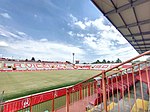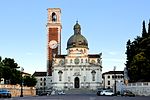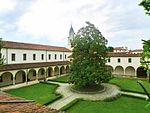Villa La Rotonda
Andrea Palladio buildingsBuildings and structures completed in 1592DomesHistoric house museums in ItalyHouses completed in the 16th century ... and 6 more
Museums in VenetoPalladian villas of VenetoRenaissance architecture in VicenzaRotundas in EuropeVillas in VicenzaWorld Heritage Sites in Italy

Villa La Rotonda is a Renaissance villa just outside Vicenza in Northern Italy designed by Italian Renaissance architect Andrea Palladio, and begun in 1567, though not completed until the 1590s. The villa's official name is Villa Almerico Capra Valmarana, but it is also known as "La Rotonda", "Villa Rotonda", "Villa Capra", and "Villa Almerico Capra". The name Capra derives from the Capra brothers, who completed the building after it was ceded to them in 1592. Along with other works by Palladio, the building is conserved as part of the World Heritage Site "City of Vicenza and the Palladian Villas of the Veneto".
Excerpt from the Wikipedia article Villa La Rotonda (License: CC BY-SA 3.0, Authors, Images).Villa La Rotonda
Via della Rotonda, Vicenza Santa Caterina
Geographical coordinates (GPS) Address External links Nearby Places Show on map
Geographical coordinates (GPS)
| Latitude | Longitude |
|---|---|
| N 45.5315 ° | E 11.5603 ° |
Address
Villa Capra "La Rotonda" (Villa Almerico Capra)
Via della Rotonda
36100 Vicenza, Santa Caterina
Veneto, Italy
Open on Google Maps










